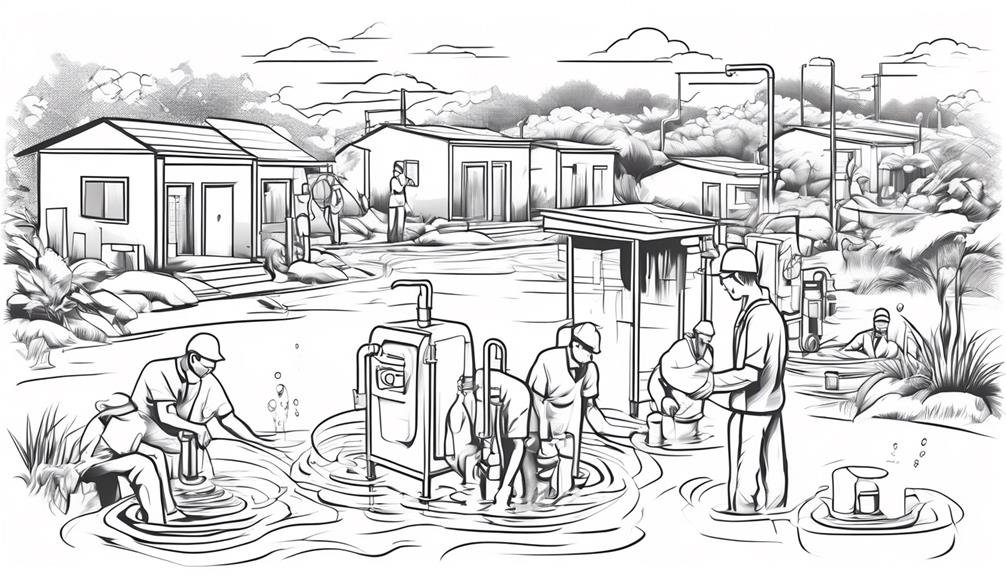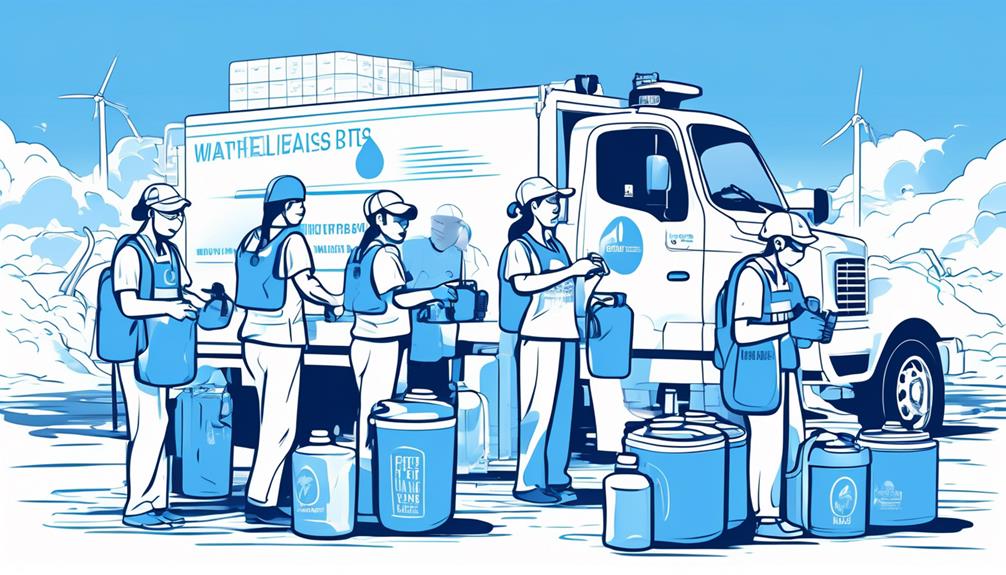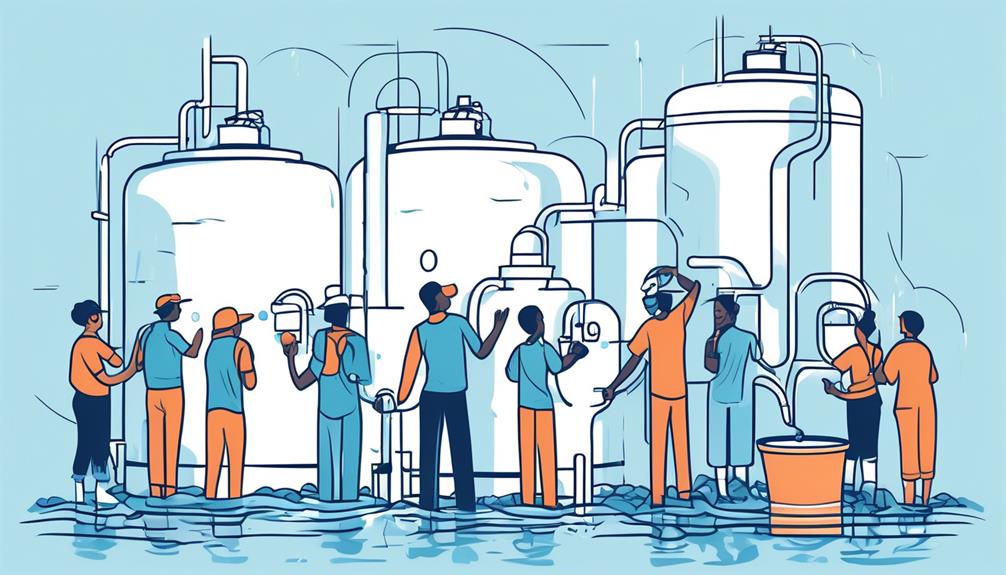Have you ever wondered how disaster-prone areas can effectively combat waterborne diseases?
In regions vulnerable to natural calamities, safeguarding communities against the threat of waterborne illnesses is crucial.
By implementing a series of strategic measures, individuals can significantly reduce the risk of disease outbreaks and ensure the well-being of those affected by disasters.
These proven strategies are not only practical but also essential for maintaining public health and safety in challenging circumstances.
Key Takeaways
- Prioritize infrastructure resilience and maintenance to prevent water contamination
- Emphasize hygiene promotion and education to reduce the risk of waterborne diseases
- Implement water quality monitoring and purification systems for safe water consumption
- Conduct regular contaminant testing and management to ensure water safety
Building Resilient Water Infrastructure
To ensure the long-term functionality of water infrastructure in disaster-prone areas, prioritize incorporating resilience into the construction and maintenance processes. By focusing on building resilient water systems, you can better withstand the impact of disasters like floods or earthquakes.
Start by using durable materials that can withstand extreme conditions. Reinforce structures to prevent damage and ensure continued water access during emergencies. Regular maintenance is crucial; check for leaks, corrosion, or weak points that could compromise the system.
Implementing backup systems, such as alternative power sources or redundant pipelines, can help maintain water supply in case of failures. Additionally, consider elevating critical infrastructure to avoid flooding and contamination risks.
Promoting Hygiene Education
When it comes to preventing waterborne diseases in disaster-prone areas, promoting hygiene education is key.
You need to understand the importance of simple practices like handwashing, proper food handling, and safe water consumption.
These habits can make a significant difference in keeping you and your community safe during challenging times.
Importance of Handwashing
Promoting hygiene education by emphasizing the importance of thorough handwashing remains a crucial strategy in preventing waterborne diseases in disaster-prone areas. To effectively convey the significance of handwashing, consider the following tips:
- Proper Technique: Scrub hands with soap and water for at least 20 seconds.
- Key Times: Wash hands before eating, after using the toilet, and after handling contaminated items.
- Use of Soap: Ensure soap is available and used during handwashing.
- Encouragement: Motivate others to wash their hands regularly, especially in emergency situations.
Proper Food Handling
How can you ensure that food handling practices promote hygiene education effectively in disaster-prone areas?
When handling food in areas susceptible to disasters, prioritize cleanliness. Start by washing your hands thoroughly before and after preparing food. Use clean utensils and surfaces to prevent contamination. Keep raw foods separate from cooked foods to avoid cross-contamination. Ensure that all foods are properly cooked and stored at the correct temperatures to prevent bacterial growth.
In disaster-prone areas, where resources may be limited, make the most of what you have by improvising with basic hygiene practices. Educate yourself and those around you on safe food handling techniques to reduce the risk of waterborne diseases. Remember, proper food handling is crucial in safeguarding your health during challenging times.
Safe Water Consumption
To ensure safe water consumption and promote hygiene education in disaster-prone areas, prioritize the purification and sanitation of water sources. Here are four essential steps to help you safeguard your water supply:
- Boil Water: Heat water to a rolling boil for at least one minute to kill harmful bacteria and parasites.
- Use Water Purification Tablets: These tablets are easy to use and can effectively disinfect water.
- Install Water Filters: Consider installing filters that can remove impurities and contaminants from your water source.
- Store Water Properly: Use clean, airtight containers to store water and prevent contamination.
Ensuring Safe Drinking Water Supply
When it comes to ensuring safe drinking water supply in disaster-prone areas, remember to use water purification methods and conduct regular water quality testing.
These practices are crucial in preventing waterborne diseases and keeping communities healthy.
Water Purification Methods
Ensuring a safe drinking water supply in disaster-prone areas necessitates implementing effective water purification methods. Here are four vital methods to ensure your water is safe to drink:
- Boiling: Boil water for at least one minute to kill harmful bacteria and pathogens.
- Chlorination: Add liquid chlorine bleach following the recommended guidelines for proper disinfection.
- Filtration: Use a water filter or purifier to remove contaminants and impurities.
- Solar Disinfection: Leave water in clear plastic bottles in the sun for 6 hours to kill germs using UV radiation.
Regular Water Quality Testing
Implementing effective water purification methods is crucial in disaster-prone areas; now, let's shift our focus to the importance of regular water quality testing for ensuring a safe drinking water supply. Regular water quality testing is essential to detect any contaminants that may pose a health risk. By consistently monitoring the water quality, you can prevent potential outbreaks of waterborne diseases. Here is a simple table highlighting key parameters to test for in drinking water:
| Parameter | What it Tests |
|---|---|
| Turbidity | Clarity of the water |
| pH Level | Acidity/alkalinity of the water |
| Chlorine Residual | Presence of disinfectant |
| Bacteria Concentration | Levels of harmful bacteria |
Implementing Proper Sanitation Practices

To maintain hygiene in disaster-prone areas, prioritize the establishment of efficient waste disposal systems. Proper sanitation practices are crucial in preventing waterborne diseases. Here are four essential steps to help you implement effective sanitation measures:
- Build Proper Toilet Facilities: Construct toilets that are located away from water sources to prevent contamination. Ensure these facilities are regularly cleaned and maintained.
- Promote Handwashing: Educate the community on the importance of handwashing with soap after using the toilet and before handling food. Provide access to handwashing stations with clean water and soap.
- Manage Solid Waste: Set up a system for collecting and disposing of solid waste properly. Encourage recycling and composting to reduce the amount of waste that needs disposal.
- Train Community Members: Conduct training sessions to raise awareness about proper sanitation practices. Empower individuals to take responsibility for maintaining cleanliness in their surroundings.
Conducting Regular Water Quality Testing
To ensure safe water sources, it's crucial to test for contaminants regularly. Keep monitoring water safety consistently to prevent potential risks.
Testing for Contaminants Regularly
Regular water quality testing is crucial for identifying and preventing contaminants in disaster-prone areas. To effectively manage water safety, consider the following steps:
- Schedule Routine Testing: Establish a regular schedule for water quality assessments.
- Utilize Reliable Testing Methods: Ensure that tests are accurate and reliable for detecting various contaminants.
- Monitor Changes in Results: Stay vigilant for any fluctuations or abnormalities in test results.
- Take Immediate Action: If contamination is detected, take prompt measures to address the issue and prevent further risks.
Monitoring Water Safety Consistently
Ensure consistent monitoring of water safety by conducting regular water quality testing to safeguard against potential contaminants in disaster-prone areas.
Regular testing is crucial to detect any harmful substances that may have entered the water supply during a disaster. By consistently monitoring water quality, you can identify any issues promptly and take necessary actions to prevent waterborne diseases.
Testing for common contaminants like bacteria, viruses, and chemicals is essential to ensure the water is safe for consumption and daily use. Establishing a routine testing schedule and following strict protocols will help maintain water safety standards in disaster-prone areas.
Ensuring Clean Drinking Water
For consistently safe drinking water, regularly conduct water quality testing in disaster-prone areas to prevent contamination and safeguard public health. Here are four essential reasons why conducting regular water quality testing is crucial:
- Early Detection: Testing helps identify contaminants promptly, allowing for immediate corrective actions.
- Compliance: Ensures that water meets regulatory standards, keeping it safe for consumption.
- Preventive Measures: By monitoring regularly, you can proactively address any issues before they become serious threats.
- Public Health: Testing ensures that the water is free from harmful pathogens, protecting the well-being of the community.
Establishing Emergency Response Plans
In preparing for potential disasters, it is vital to establish clear and effective emergency response plans. These plans serve as crucial roadmaps to ensure a coordinated and efficient reaction when a crisis strikes. Here are key components to consider when creating emergency response plans:
| Component | Description | Importance |
|---|---|---|
| Risk Assessment | Identify potential hazards and vulnerabilities. | Understanding risks aids in preparation. |
| Communication Strategy | Establish protocols for internal and external comms. | Clear communication is vital for coordination. |
| Emergency Protocols | Define specific actions to take during emergencies. | Well-defined protocols guide quick responses. |
Distributing Water Purification Kits

To enhance water quality in disaster-prone areas, consider implementing a systematic distribution plan for water purification kits. Distributing these kits can significantly reduce the risk of waterborne diseases. Here's how you can effectively distribute water purification kits:
- Assessment: Begin by conducting a thorough assessment of the area to determine the number of kits required and the most accessible distribution points.
- Collaboration: Partner with local organizations, authorities, and volunteers to ensure efficient distribution and reach a larger population.
- Education: Provide clear instructions on how to use the water purification kits effectively to ensure they're used correctly.
- Monitoring: Establish a system to monitor the distribution process and gather feedback from recipients to improve future distribution efforts.
Encouraging Proper Waste Management
Encourage responsible waste management practices to safeguard public health and the environment in disaster-prone areas. Proper waste disposal is crucial in preventing waterborne diseases. When disasters strike, waste management often takes a back seat, but it's essential to prioritize it to avoid further health risks.
In disaster-prone areas, promoting the separation of different types of waste can significantly impact disease prevention. Encourage the community to segregate biodegradable waste from non-biodegradable waste to facilitate proper disposal methods. Additionally, educate locals on the importance of recycling to reduce the amount of waste that ends up in water sources.
Emphasize the need for designated waste disposal areas to prevent contamination of water supplies. Implementing strict waste management protocols during emergencies can mitigate the spread of diseases caused by improper disposal practices.
Engaging Community Participation

Active community involvement is key to effectively preventing waterborne diseases in disaster-prone areas. Engaging the community in waterborne disease prevention not only creates a sense of ownership but also ensures the sustainability of interventions.
Here are four ways to encourage community participation:
- Education Campaigns: Conduct informative sessions on waterborne diseases, their causes, and prevention methods to raise awareness within the community.
- Training Workshops: Organize workshops to teach community members about proper hygiene practices, safe water storage, and sanitation techniques.
- Community Clean-Up Drives: Initiate clean-up activities in water sources and surrounding areas to reduce contamination risks and promote a cleaner environment.
- Establish Community Committees: Form committees to oversee water quality monitoring, maintenance of water sources, and implementation of disease prevention strategies.
Providing Adequate Health Care Services
Providing adequate health care services is crucial in safeguarding the well-being of individuals in disaster-prone areas. During disasters, access to medical care becomes even more critical. Immediate medical attention can prevent minor illnesses from escalating into major health crises. Mobile medical units are a practical solution, offering on-the-spot treatment for injuries and illnesses. These units can reach remote areas cut off by disaster, ensuring that everyone receives the care they need.
Moreover, setting up temporary health clinics in evacuation centers is vital. These clinics can provide basic medical services, distribute necessary medications, and monitor the health of vulnerable populations such as children and the elderly. By having healthcare professionals on-site, prompt intervention can be initiated, reducing the risk of disease outbreaks.
Collaboration between local health authorities, NGOs, and government agencies is essential to coordinate efforts effectively. Training community members in basic first aid and hygiene practices can also empower individuals to take control of their health during emergencies. By prioritizing adequate health care services, we can protect lives and prevent the spread of waterborne diseases in disaster-prone areas.
Frequently Asked Questions
How Can Local Communities Be Involved in the Planning and Implementation of Waterborne Disease Prevention Strategies in Disaster-Prone Areas?
You can be part of planning and implementing waterborne disease prevention in disaster-prone areas. Get involved through community meetings, educating others, and working with local authorities to ensure clean water sources and proper sanitation in your area.
What Role Do Government Agencies Play in Ensuring the Sustainability of Water Infrastructure in Disaster-Prone Areas?
Government agencies play a crucial role in ensuring the sustainability of water infrastructure in disaster-prone areas. They oversee planning, funding, and maintenance, working to protect communities from waterborne diseases through reliable systems and timely interventions.
How Can Technology Be Utilized to Improve Water Quality Testing and Monitoring in Disaster-Prone Areas?
To enhance water quality testing and monitoring in disaster-prone areas, technology offers a crucial solution. Utilize innovative sensors for real-time data collection. With these tools, you can swiftly identify contaminants, ensuring safer water sources for communities.
What Are Some Challenges Faced in Promoting Proper Waste Management Practices in Disaster-Prone Areas, and How Can They Be Addressed?
In disaster-prone areas, challenges like inadequate infrastructure and limited resources hinder waste management. Encourage community involvement, provide education, and implement sustainable solutions. Emphasize proper disposal methods and recycling to mitigate health risks and protect the environment effectively.
How Can the Effectiveness of Emergency Response Plans in Preventing Waterborne Diseases Be Evaluated and Improved Upon?
To evaluate and enhance emergency response plans for preventing waterborne diseases, assess past responses, gather feedback from frontline workers, and engage with communities. Implement changes based on findings to ensure plans are effective and responsive.
Conclusion
Now that you have the tools to combat waterborne diseases in disaster-prone areas, imagine a community flourishing like a blooming garden, free from the dark clouds of illness.
By implementing these strategies, you can help create a shield of protection against waterborne threats, ensuring a safer and healthier environment for all.
Together, we can build a fortress of resilience, where clean water flows like a crystal-clear river, nourishing the roots of our communities.